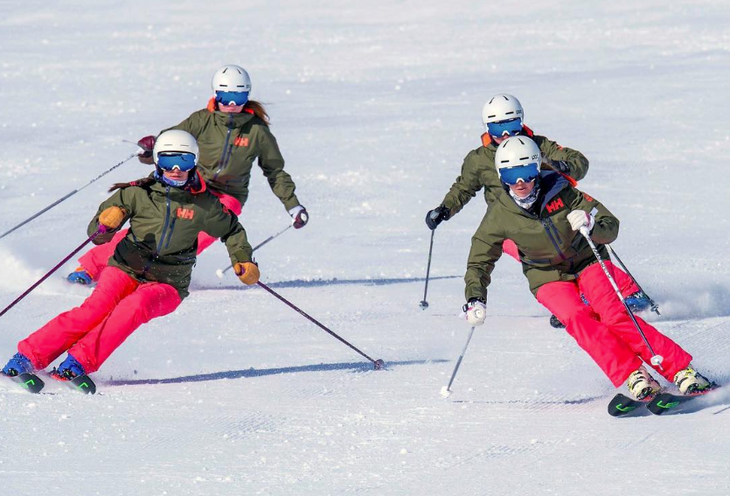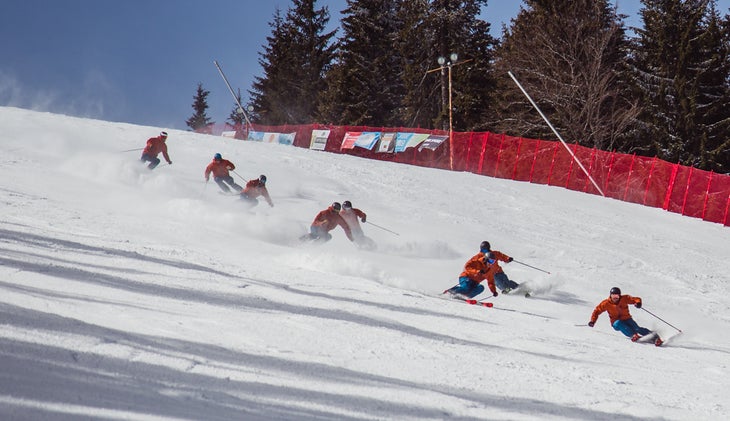Products You May Like
Get full access to Outside Learn, our online education hub featuring in-depth fitness, nutrition, and adventure courses and more than 2,000 instructional videos when you sign up for Outside+
Sign up for Outside+ today.
On a recent warm and sunny Saturday at Aspen Mountain, the crowd on the deck of Bonnie’s restaurant hooted and hollered for the competitors coming down the North American run. Eight skiers at a time sped down the hill in choreographed formations, turning in unison and criss-crossing each other’s lines while a DJ spun a tune for each team, ranging from thumping techno to AC/DC. Picture a mash-up of high-performance short turns with a little Powder 8s and a dash of ’70s freestyle thrown in.
After a two-year Covid hiatus, the Aspen World Synchro Championships had returned, and a half dozen teams comprised of ski instructors—all on 165-cm slalom boards—were vying for bragging rights on the second day of competition, after a day of racing and mogul bashing. The skiers came from Telluride, Big Sky, Argentina and just down the hill in Aspen.
This is no X Games, yet the competitors are clearly psyched on synchro. Why? “For the love of skiing and the level of performance,” says Peter Steiner, who’s skied with the all-male Telluride Ghostriders for 13 years. “Skiing at that level is thrilling.”
Thrilling, indeed. Imagine eight slalom racers trying to synch up their turns within close proximity of each other. Synchro skiers deserve way more props than they generally get.
“It’s pretty amazing what they do,” says Ken Canfield, a longtime Aspen Mountain skier who was watching the championships. The close proximity of skiers and potential for high-consequence crashes aside, synchro skiing is especially impressive because it shows off the short turns and dynamic rhythm changes that have been supplanted by today’s longer radius arcs.

During an event, teams generally ski four runs, or passes; each lasts about 30 seconds, with skiers making 30 to 40 turns down the hill. All of the teams—whether female, male or co-ed—compete against each other, receiving points in five categories that range from synchronicity and technique to how well they conformed to their planned routine (judges get diagrams beforehand). In 2014, racing (on Aspen Mountain’s NASTAR course) and moguls were added, and each team sends four skiers to race and two to compete head to head in bumps. Those scores are then rolled into the overall standings.
As for the music, “you pick songs that are fun and that show off the cadence of your turn,” says Jen Rupert, a current instructor who competed with the all-women Aspen Divas for 18 years. “Different ski schools might have different turns, and different countries have different skiing styles.” The common element? Showing off technical skill and precision.
Call it off-beat—except that’s literally the opposite of what it is. The key to skiing in formation without taking each other out is counting. One skier counts aloud down to the start, then everyone counts in their heads as they ski. Says John Balmain of the Ghostriders, “It’s a real adrenaline rush. You’re trusting your teammates, and the consequences are high.” In other words, mess up your own rhythm, and you risk messing up everyone else.

For instructors, the end-of-season competition also allows them to let loose, in their own way. During the winter, says Rupert, “we all work our asses off. By the time spring comes, we need to ski for the love of skiing.”
Another part of the appeal, notes Diego Marro, a coach and skier with the all-male, Aspen-based Argenteam, is that synchro morphs skiing from an individual into a team sport, with all of the friendship and common purpose that entails. “It’s so worth it to wake up early two or three times a week to train for this event,” says Carolina Vivo, captain of the Divas. There’s also a strong camaraderie among the different teams, making the competition more collegial than cut-throat.
The sport’s roots lie in the coordinated ski demos at Interski, a once-every-four-years symposium of the world’s best ski instructors that dates back decades. At Interski, instructors come together to trade insight on technique and teaching and, during those synchronized demos, show off their ski skills as a country. Synchro’s U.S. heyday came during the 1990s, when Vail Mountain hosted an annual championship that was also known as the Battle of the Ski Schools (sponsored, in part, by SKI). Some 30 international teams (a few even made up of snowboarders or telemark skiers) competed for prize money on courses that included a pair of big kickers.
After the loss of a major sponsor, the championships moved to Whistler in 2002, and the next year to Aspen, where they’ve been held ever since. As recently as 2017, 14 teams competed, and the hope is to find more sponsorship dollars and build back up the number of participants. Elsewhere, a South American synchro championship takes place in Argentina every September, and European ski areas host a smattering of comps.
What keeps instructors hanging on in spite of synchro’s downhill slide? For one, there’s the hope that the competitions will ramp up again post-Covid. The Aspen organizers already know of more teams that plan to attend next year. And then there’s the reward of being able to send it in front of their peers. “The only other time you get to perform at your highest level is at an exam,” says Fangman, referring to the certification tests that instructors must take. A synchro event allows instructors to show off just for each other. “For people who spend their lives speaking good skiing, it’s hard to let that go,” adds Fangman. “This is our shtick. We’re going to hold onto it as long as we can.”
By mid-afternoon at the Aspen championships, the Divas had skied their way into first place, edging out the co-ed Nomads, a group of instructors from Argentina who chase winter around the world, along with the other four teams (best name: Big Sky’s Sync or Swim). Within a few hours, the skiers would be celebrating at a party in town—all together, of course.
